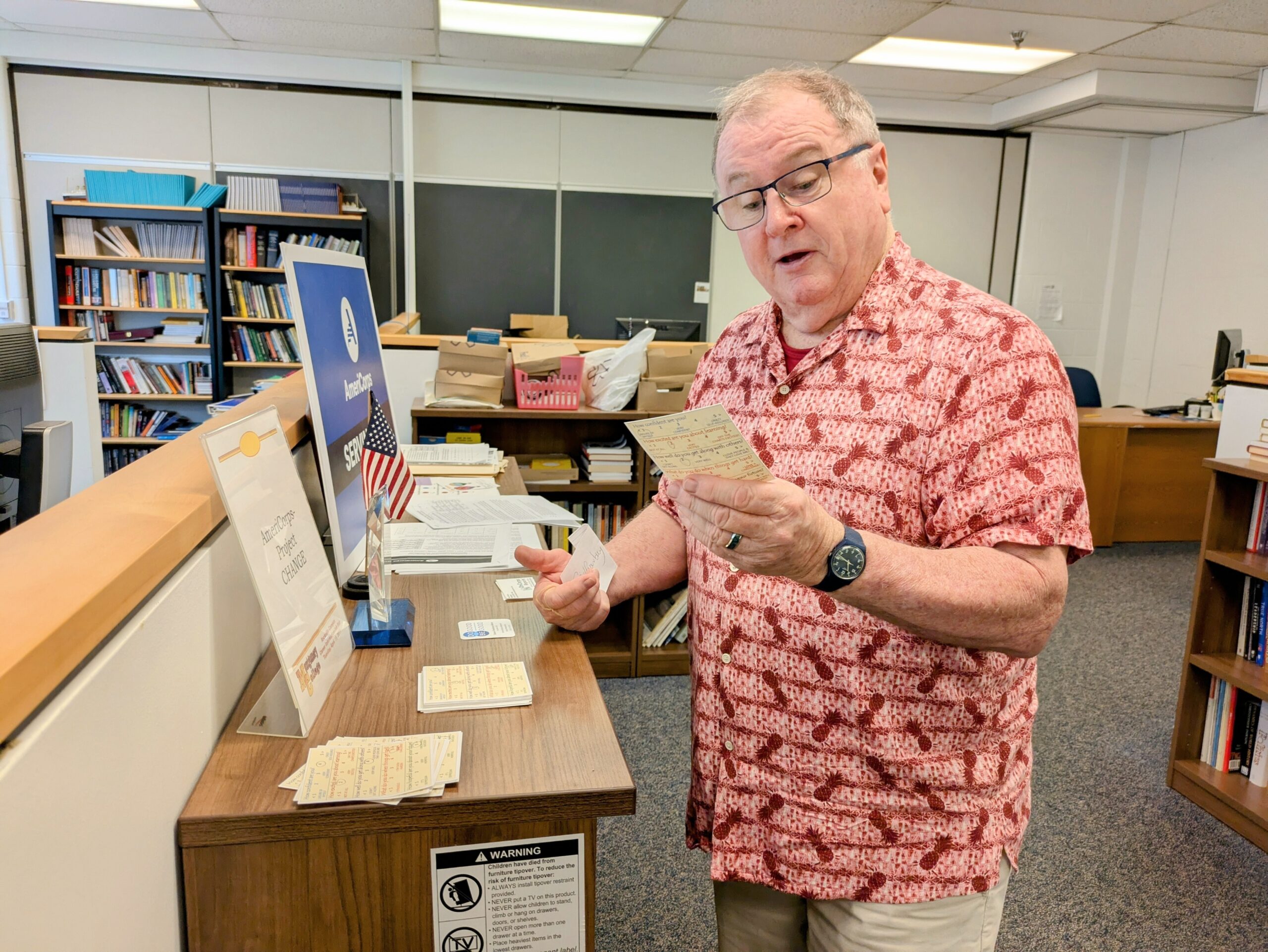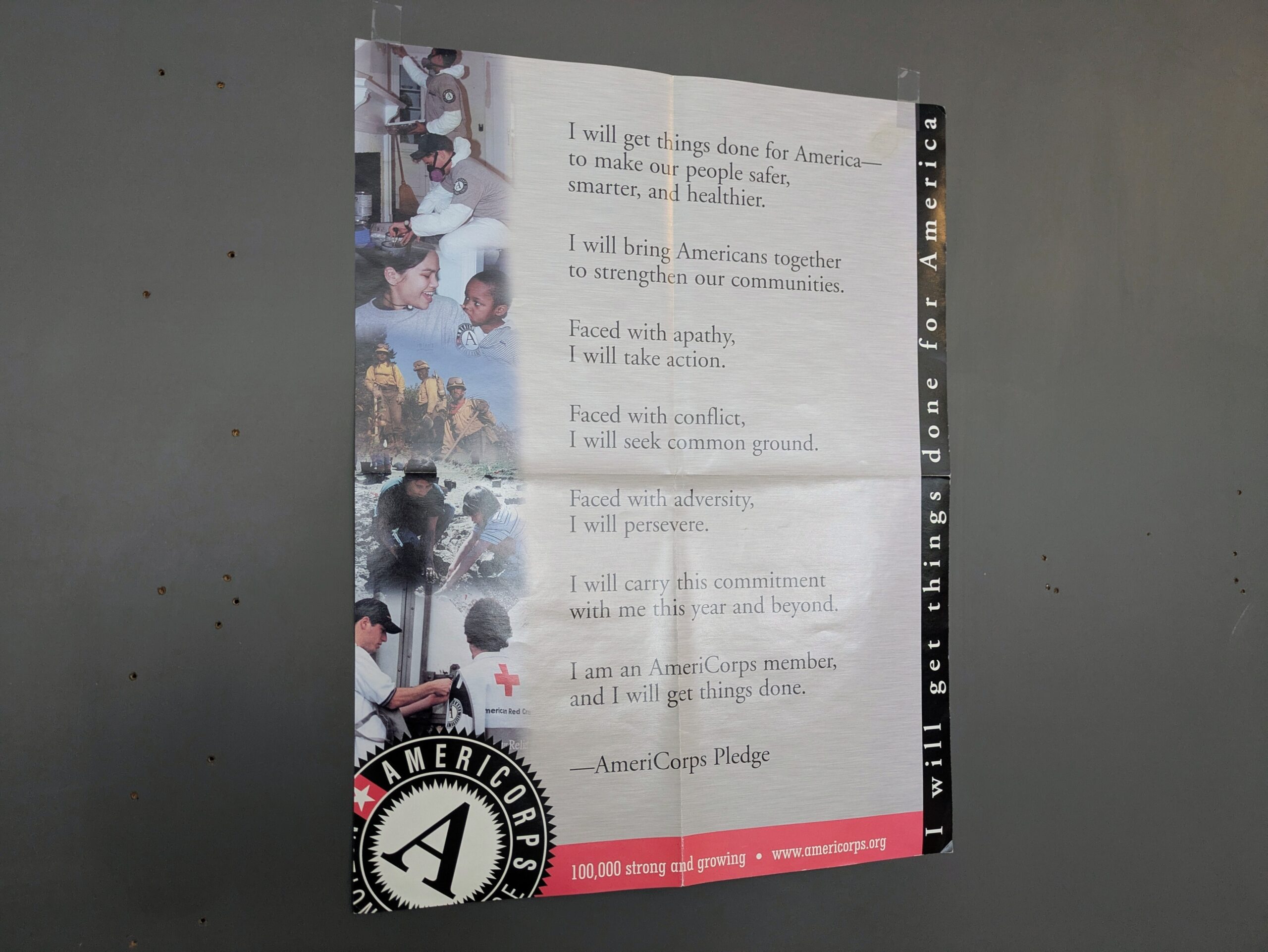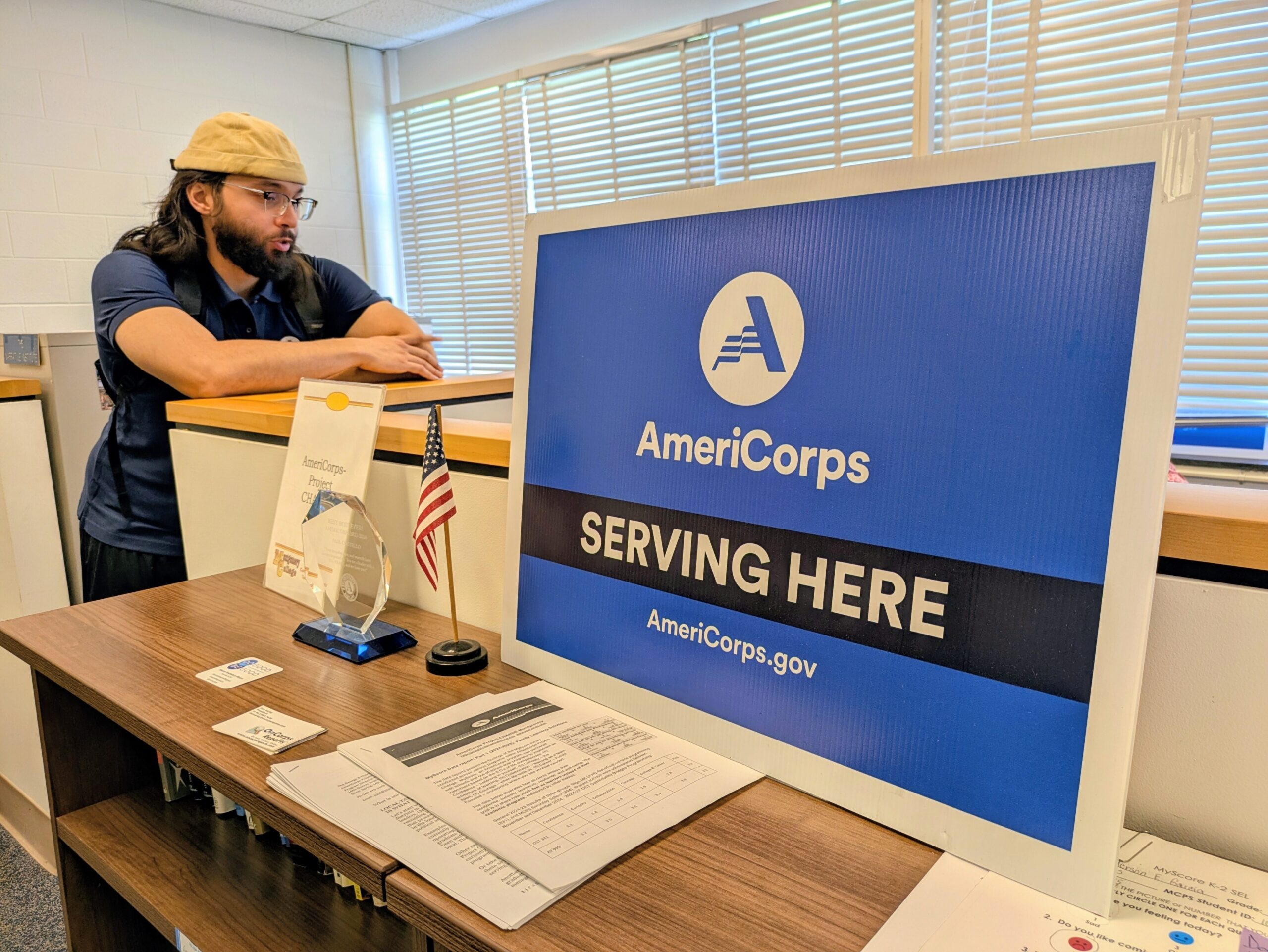Former AmeriCorps service member Daniel Zare, 27, visits Project Change at Sligo Middle School on Monday, Aug. 11, 2025 in Silver Spring, Maryland, where he mentored students before federal government cuts in April. (Photo by Ashley Murray/States Newsroom)
SILVER SPRING, Md. — Daniel Zare worked one-on-one as an AmeriCorps member with students going through rough times in school, lightening teachers’ workload in the classroom.
At AmeriCorps Project CHANGE, based in Silver Spring’s Sligo Middle School, Zare was one of several in his group who tracked adolescents’ emotional and social wellbeing over months using a system dubbed “My Score.” They then helped support the kids who were struggling the most.
In April, though, the program screeched to a halt. That’s when the Trump administration abruptly canceled nearly $400 million in active AmeriCorps grants across the United States that fund volunteers who embed in communities, in exchange for a small stipend and education award.
“All the work that we had culminating toward the end of the year, the relationships that we built with teachers and students and officials, it just completely went kaput because we were told we weren’t allowed to go to work at all,” Zare, 27, told States Newsroom.
Like so many longstanding federal programs and institutions severely reduced or dismantled as part of President Donald Trump and billionaire Elon Musk’s Department of Government Efficiency project, AmeriCorps — and its nonprofit partners — are now assessing the damage and seeking a way forward.
AmeriCorps programs that survived last spring’s DOGE cuts are slowly beginning a new year of service amid major uncertainty over whether they will be able to continue their work in classrooms, food banks, senior centers and other community hubs.
Winners and losers among states
AmeriCorps, a federal agency signed into law in 1993 by former President Bill Clinton, places roughly 200,000 members across the United States at 35,000 service locations, according to current agency data.
Members serve in schools, local governments and with a wide range of nonprofits that focus on health, disaster relief, environmental stewardship, workforce development and veterans.
The staffers, who pledge to “get things done for America,” are paid a modest living allowance that hovers around the poverty line. Some, but not all, can get health insurance while in the program.
Members who complete their service term, which usually lasts from 10 to 12 months, receive an education award that can be used to pursue a degree, earn a trade certificate or pay student loans.
AmeriCorps federal dollars reach programs via a couple routes. In many cases, grants flow from AmeriCorps to governor-led state and territorial commissions that divvy them up according to local priorities. In other cases, federal dollars flow straight to a program via a competitive grant process.
Kaira Esgate, CEO of America’s Service Commissions, said when the Trump administration ordered the cuts in April, some states lost large portions of their AmeriCorps portfolio, while other states fared better.
“There were no real clear trend lines around what or who got terminated and why,” said Esgate, whose member organization represents all 49 state commissions (South Dakota doesn’t have one) and the commissions for the District of Columbia, Guam and Puerto Rico.
Abby Andre, executive director of The Impact Project, a new nonprofit tracking government cuts, has been collecting data and plotting on an interactive map where AmeriCorps programs have been canceled. Andre, a former Department of Justice litigator, has also worked with her team to build other maps showing where federal workforce cuts have been felt across the country.
“AmeriCorps is a really great example of the federal dollars being kind of invisible in communities. Communities often don’t know that a local food bank or a senior center are supported by AmeriCorps volunteers and AmeriCorps money,” said Andre, who taught administrative law at the Vermont Law School after working under President Barack Obama and in Trump’s first administration.
Andre said communities with a lack of social services, including in rural areas, will likely feel the biggest losses without an AmeriCorps presence because the agency “facilitates pennies-on-the-dollar type services through volunteer work.”
“It’s not as though if these community services folded, those communities would have the money to fund equal or better services through the private market,” she said.
Losing trust
The Maryland Governor’s Office on Service and Volunteerism gave the green light to Project CHANGE to keep its program, which serves Montgomery County in suburban Washington, D.C., running through the upcoming school year.
Paul Costello, director of Project CHANGE, is now scrambling to launch a new AmeriCorps cohort after receiving the news on July 22 that the initiative had been funded. He estimates members won’t be able to begin until almost a month into the school year.

“Sadly, AmeriCorps, as a brand name, is badly damaged, I think. I mean, I’ve got a meeting on Wednesday with a major partner who told us two weeks ago ‘We thought you were dead,’” Costello told States Newsroom in an Aug. 11 interview.
Costello’s program not only places service members in Montgomery County Public Schools, where Zare served, but also with partners including Community Bridges, Montgomery Housing Partnership and Family Learning Solutions.
The nonprofits respectively focus on helping adolescent girls from diverse backgrounds, children whose families live in community-developed affordable housing units and teens eyeing college and career paths.
The county’s school system is the largest in the state and serves a highly diverse population. About 44% of the system’s 160,000 students qualify for free and reduced meals, and close to 20% are learning English while continuing to speak another language at home.
Costello’s 18 cohort members embedded in those schools and nonprofits this past academic year were suddenly yanked in April when the government cut his grant. The partners, which had planned and budgeted to have the members through June, were thrown into “total chaos,” Costello said.
“So some of them are so desperate, they rely on their members. They had to dig into their pockets to keep them on as staff. And then we go back to them this year and say, ‘You want members this year?’ AmeriCorps has made no attempt to make them whole. So they’ve been screwed,” Costello said.
AmeriCorps did not respond to States Newsroom’s questions about nonprofits losing money.
Legal action
The federal courts granted some relief to members and organizations who abruptly lost living allowances and contractually obligated funding.
A Maryland federal district judge ordered in June that funding and positions be restored in 24 Democratic-led states and the District of Columbia that sued the agency.
Another district judge in the state also handed a win to more than a dozen nonprofits from across the country that sued to recover funding they were owed.
But for many it was too late, and AmeriCorps’ future still feels shaky.
After suddenly losing his living allowance in April, Zare had to leave Silver Spring.
“I was renting a room off of Georgia (Avenue), and I was not able to pay rent there anymore, so I actually moved back to my mom’s in Germantown for the time being,” he told States Newsroom in August, referring to another Maryland suburb.
Hillary Kane, director of the Philadelphia Higher Education Network for Neighborhood Development, said by the time the court orders were issued, many of her AmeriCorps members had already found other positions and she had completely let go of one of her full-time staffers.
While the court injunctions were “welcome news,” reinstating the programs remained “questionable,” Kane wrote in a July 21 update for Nonprofit Quarterly.
Kane’s organization is a member of the National College Attainment Network, a Washington, D.C.-based nonprofit that was among the successful plaintiffs.
Other organizations that joined the lawsuit are based in California, Iowa, Maine, Maryland, Minnesota, New Jersey, New York, North Carolina, Pennsylvania, South Dakota and Virginia.
The Democratic-led states that won reinstatement for AmeriCorps members include Arizona, California, Colorado, Connecticut, Delaware, Hawaii, Illinois, Kentucky, Maine, Massachusetts, Michigan, Minnesota, Nevada, New Jersey, New Mexico, New York, North Carolina, Oregon, Pennsylvania, Rhode Island, Vermont, Washington, and Wisconsin.
Going forward?
Kane got news on July 10 that PennSERVE, Pennsylvania’s state service commission, reinstated funding for her AmeriCorps program that places members in four West Philadelphia high schools to mentor students on their post-graduation plans.
The late notice meant Kane could only begin recruiting new members in mid-July.
“And so our start date has to be a bit fluid,” Kane told States Newsroom during a July 22 interview. “We have to essentially recruit people into this one-year cohort position, and say, ‘We’re hoping to start September 2, but we’re not 100% sure. Can you kind of just roll with it?’ It’s an awkward position to have to be in.”

Other AmeriCorps programs have not fared so well, as the Trump administration’s Office of Management and Budget continues to withhold funds that were appropriated by Congress for the ongoing fiscal year.
Trump signed legislation in March that extended the $1.26 billion for AmeriCorps for the full 2025 fiscal year, which ends on Sept. 30.
Kane said the most “insidious” part of the recent AmeriCorps storyline is that programs that receive grants directly from the federal agency are being strung along by OMB.
“So there are agencies who have been theoretically awarded money, but they’re like, ‘Is it actually going to happen? Should I spend all this money and then not be able to bill the federal government to reimburse me if OMB is going to hold it hostage?’”
Programs at risk include 130 recently expired contracts for AmeriCorps Foster Grandparent and Senior Companions programs that support roughly 6,000 senior citizen volunteers across 35 states. The programs are eligible for just over $50 million for the new service year, which should be off to a start.
Congress pleads with budget office
A bipartisan group of U.S. senators pressed the executive branch agency on Aug. 1 to release the funds.
“Further delays in grantmaking will have immediate and irreversible consequences for programs, AmeriCorps members, and communities,” the senators wrote in a letter to OMB Director Russ Vought.
Republican Sens. Bill Cassidy of Louisiana, Susan Collins of Maine, Lisa Murkowski of Alaska and Thom Tillis of North Carolina joined Democratic Sens. Chris Coons of Delaware, Jack Reed and Sheldon Whitehouse of Rhode Island, and Senate Minority Leader Chuck Schumer of New York in signing the letter. All are members of the Senate National Service Caucus.
The White House and AmeriCorps did not respond for comment.
The Republican-led Senate Committee on Appropriations voted on July 31 to preserve $1.25 billion in AmeriCorps funding for fiscal year 2026. Collins chairs the committee.
U.S. House appropriators, which for the last two years under Republican leadership have sought to cut AmeriCorps funding, are expected to debate its budget in September. But it’s almost certain Congress will have to pass a stopgap spending bill when the end of the fiscal year arrives to stave off a partial government shutdown, so a final decision on funding may not come for months.
Change for everyone
Zare never did have a chance to say goodbye to all his students in April.
And even though the option was on the table, he did not sign up to serve a third year with AmeriCorps.
Before he applied and earned a spot with Project CHANGE, Zare was working odd jobs, including as a utilities contractor for Comcast. He had also earned his associate’s degree.

“I don’t think there’s any other program to take someone like me who was working a couple of different jobs and put them in an environment like this, to see firsthand as an American citizen how our classrooms operate and what position I would need to be in to actually be of benefit,” Zare told States Newsroom.
Zare is now freelancing and debating his next move, whether that’s a new job or further higher education.
“AmeriCorps is something that I’m always going to cherish because a lot of the people there still help me,” he said.
Editor’s note: D.C. Bureau Senior Reporter Ashley Murray served in AmeriCorps in 2009-2010.






